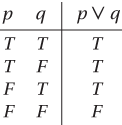If p and q are statements, then the statement ‘p or q’, denoted by p ∨ q, is the disjunction of p and q. For example, if p is ‘It is raining’ and q is ‘It is Monday’ then p ∨ q is ‘It is raining or it is Monday’. To be quite clear, notice that p ∨ q means ‘p or q or both’: the disjunction of p and q is true when at least one of the statements p and q is true. The truth table is:

This is sometimes explicitly known as ‘inclusive disjunction’ to distinguish it from exclusive disjunction (or xor) which requires exactly one of p, q to be true.
- chlorobenzene
- chlorocruorin
- chloroethane
- chloroethanoic acids
- chloroethene
- chlorofluorocarbon
- chlorofluorocarbons
- chloroform
- chloromethane
- chlorophenol
- chlorophyll
- Chlorophyta
- chloroplast
- chloroplatinic acid
- chloroprene
- chlorosis
- chlorosulphanes
- chlorous acid
- chloroxybacteria
- chlorozoan
- choanae
- Choanichthyes(*Sarcopterygii)
- Choctaw
- choice
- choice, axiom of